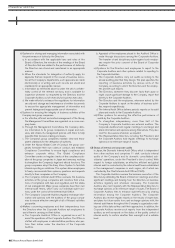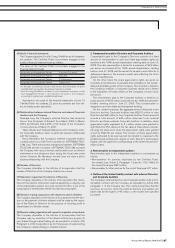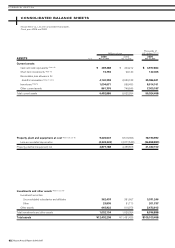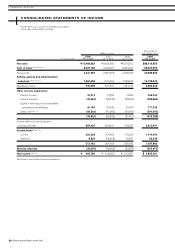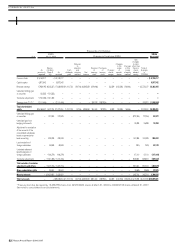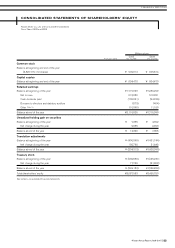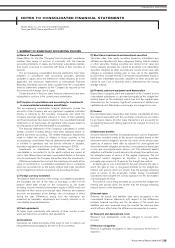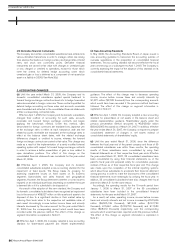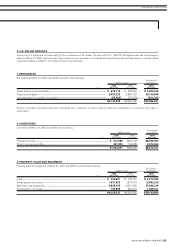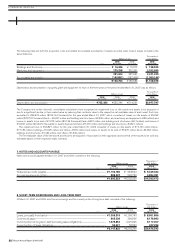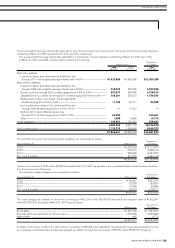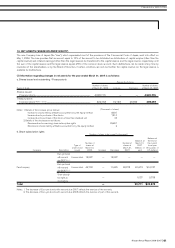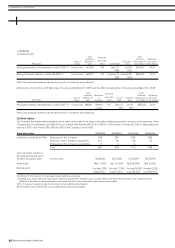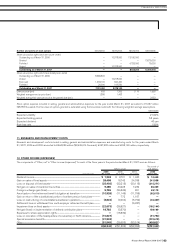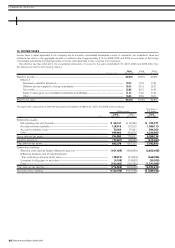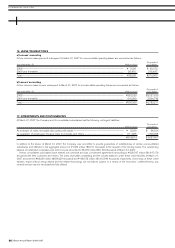Nissan 2007 Annual Report Download - page 58
Download and view the complete annual report
Please find page 58 of the 2007 Nissan annual report below. You can navigate through the pages in the report by either clicking on the pages listed below, or by using the keyword search tool below to find specific information within the annual report.
(m) Derivative financial instruments
The Company and certain consolidated subsidiaries have entered into
various derivative transactions in order to manage certain risk arising
from adverse fluctuations in foreign currency exchange rates, interest
rates, and stock and commodity prices. Derivative financial
instruments are carried at fair value with changes in unrealized gain
or loss charged or credited to operations, except for those which
meet the criteria for deferral hedge accounting under which
unrealized gain or loss is deferred as a component of net assets (an
asset or a liability in 2005). See Note 2(a).
(n) New Accounting Standards
In May 2006, the Accounting Standards Board of Japan issued a
new accounting guideline to harmonize the accounting policies of
overseas subsidiaries in the preparation of consolidated financial
statements. This accounting standard will become effective the fiscal
year commencing on or subsequent to April 1, 2008. The Company is
currently assessing the impact of the adoption of this standard on its
consolidated financial statements.
Nissan Annual Report 2006-2007
56
»FINANCIAL SECTION
2. ACCOUNTING CHANGES
(a) Until the year ended March 31, 2005, the Company and its
domestic consolidated subsidiaries applied special treatment to
forward foreign exchange contracts entered into to hedge forecasted
sales denominated in foreign currencies. These contracts qualified for
deferral hedge accounting as these sales and accounts receivable
were translated and reflected in the consolidated financial statements
at their corresponding contracted rates.
Effective April 1, 2005, the Company and its domestic subsidiaries
changed their method of accounting for such sales, accounts
receivable and forward foreign exchange contracts and began
applying the benchmark method. Under this method, sales
denominated in foreign currencies are translated into Japanese yen
at the exchange rates in effect at each transaction date and the
related accounts receivable are translated at the exchange rates in
effect at the balance sheet dates, with the related exchange
differences charged or credited to income, whereas the forward
foreign exchange contracts are carried at fair value. This change was
made as a result of the implementation of a newly modified internal
operating system with respect to forward foreign exchange contracts
in order to achieve a better presentation of gain or loss related to
open derivatives positions. The effect of this change on the
consolidated financial statements was immaterial for the year ended
March 31, 2006.
(b) Effective April 1, 2005, the Company and its domestic
consolidated subsidiaries adopted a new accounting standard for the
impairment of fixed assets. The Group bases its grouping for
assessing impairment losses on fixed assets on its business
segments (automobiles and sales finance) and geographical
segments. However, the Group determines whether or not an asset is
impaired on an individual asset basis depending on whether the asset
is deemed idle or if it is scheduled to be disposed of.
As a result of the adoption of this new standard, the Company and
its domestic consolidated subsidiaries have recognized an impairment
loss in the amount of ¥26,827 million on idle assets and assets to be
disposed of due to a significant decline in their market value by
reducing their book value to the respective net realizable value of
each asset. Accordingly, income before income taxes and minority
interests decreased by the same amount for the year ended March
31, 2006 from the corresponding amount which would have been
recorded under the previous method. The effect of this change on
segment information is explained in Note 21.
(c) Effective April 1, 2006, the Company adopted a new accounting
standard for share-based payment and related implementation
guidance. The effect of this change was to decrease operating
income, income before income taxes and minority interests by
¥1,037 million ($8,788 thousand) from the corresponding amounts
which would have been recorded if the previous method had been
followed. The effect of this change on segment information is
explained in Note 21.
(d) Effective April 1, 2006, the Company adopted a new accounting
standard for presentation of net assets in the balance sheet and
related implementation guidance. Shareholders’ equity under the
previous presentation method amounted to ¥3,543,420 million
($30,028,983 thousand) as of March 31, 2007. In addition, effective
the year ended March 31, 2007, the Company is required to prepare
consolidated statement of changes in net assets instead of
consolidated statements of shareholders’ equity.
(e) Until the year ended March 31, 2006, since the difference
between the fiscal year end of the parent company and those of 55
consolidated subsidiaries was within three months, the operating
results of those subsidiaries were consolidated by using their
financial statements as of their respective fiscal year ends. Effective
the year ended March 31, 2007, 22 consolidated subsidiaries have
been consolidated by using their financial statements as of the
parent’s fiscal year end prepared solely for consolidation purposes
instead of those as of their respective fiscal year end. This change
was made, upon the completion of the internal reporting systems
which allow those subsidiaries to accelerate their financial statement
closing process, in order to make the disclosures of the consolidated
financial statements more meaningful by unifying the fiscal year. In
addition, 33 consolidated subsidiaries have also changed their fiscal
year end to March 31 for the same reason.
Accordingly, the operating results for the 15-month period from
January 1, 2006 to March 31, 2007 of the 55 consolidated
subsidiaries have been included in the consolidated financial
statements for the year ended March 31, 2007.
As a result, net sales, operating income, income before income
taxes and minority interests and net income increased by ¥767,606
million ($6,505,136 thousand), ¥21,443 million ($181,720
thousand), ¥15,661 million ($132,720 thousand) and ¥11,589
million ($98,212 thousand), respectively, over the corresponding
amounts which would have been reported under the previous method.
The effect of this change on segment information is explained in
Note 21.


